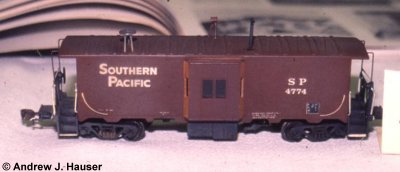
Construction of a Southern Pacific C-50-9 Caboose
(from an Athearn shell and Detail Associates underframe)
By Andrew Hauser ©
SOUTHERN PACIFIC C-50-9 CABOOSE.
1. Construction
This project starts with an undecorated Athearn bay window caboose, a Detail Associates cushion under frame kit, and other assorted detail parts from Detail Associates and other companies.
The Athearn caboose frame and body were constructed using various commercial parts (Grab Irons, Platform steps, train line hoses, window glazing and hand brakes). Details were fabricated from brass wire (end platform railings, train lines) plastic (plastic edge for bottom step, plugs for caboose floor, collision posts, gussets for hand brake, backing plate for hand brake, window plugs, roof walk plugs and battery box body) brass sheet (end railing safety plates)
2. Detail
The body consists of the stock Athearn body with two types of Detail Associates Caboose grabs added to the ends, sides and on both sides of the coupler. All the body plugs were made from various sizes of Plastruct plastic attached with liquid cement. The caboose platforms were reworked using a Photo Etched Caboose platform kit from Detail Associates. The end railings are hand-formed from various pieces of Detail Associates ¾" brass wire. The hand railings were soldered together on the caboose to ensure an exact fit. Added to the stock frame was a Details West Cushioned Under Frame Kit. Kadee # 5ís couplers were added to each end.
3. Conformity
The C-50-9 Caboose, also known as the 'Urban Guerilla' were built for the Southern Pacific by PACCAR from March to May of 1980. These cabooses were numbered in the #4700-4774 series. This class of caboose was the last of the C-50 series purchased new by the Southern Pacific. After building, most cabooses of this series were placed in storage to await an upswing in business. (See SP Review 1981 page 33)
4. Finishing and lettering;
The caboose is finished to resemble a Southern Pacific C-50-8 caboose. The exterior is finished using Floquil primer mixed 50/50 with thinner. After drying the ends were sprayed a mixture of Floquil SP Daylight Orange and thinner. After drying the ends were masked the body was painted a mixture of Floquil Tucson Red and thinner. The frame and floor were sprayed with a 50/50 mixture of Floquil Engine Black and Thinner. Herald King decals were used for all decaling requirements and they were sealed with a mixture of flat finish and thinner.
Once the shell had dried I detail painted the grab irons, these were painted with Floquil Reefer White. The weathering was done with a mixture of weathering chalk and an airbrush using Floquil Grimy black, dust and mud. All weathering was again sealed with Floquil Flat Finish. After the last coat of flat finish had dried for a couple of days the windows were added.
5. Scratch building:
Parts of the caboose body, frame and end railings are scratchbuilt. A summary list of exempt, scratchbuilt and commercial components used in the modelís construction is attached. The caboose is composed of 65 scratchbuilt parts and 36 commercial parts, and overall it is 64% scratchbuilt.
|


![website logo for use in banner exchange [185 x 50] (5k)](gifs/logo.gif)